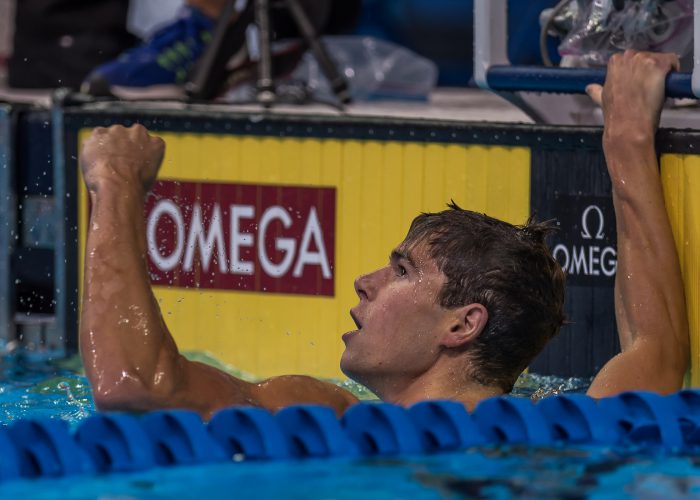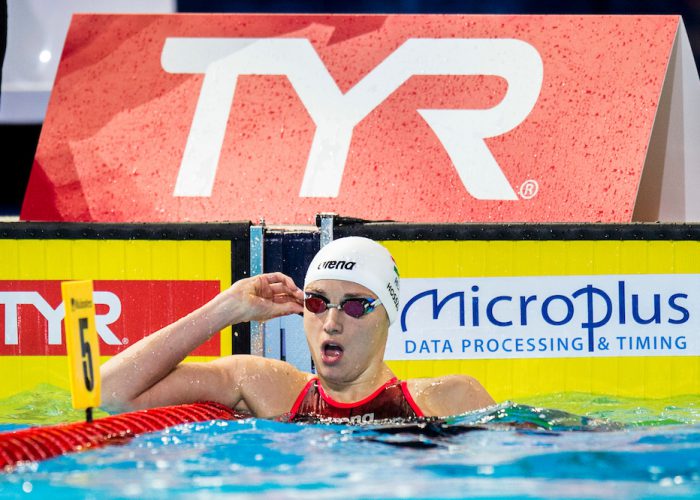Translating Short Course Success to Long Course Dominance: The Classic Conundrum

Commentary By Eamonn Keenan, Swimming World College Intern.
Many of America’s top yards swimmers perform equally as fast in meters, but why are some of the most elite short course swimmers far less dominant in the big pool? This is a difficult question to answer – as many variables are at play – but one that is crucial to consider for the future development of US National Team.
NCAA Division I Championships vs. The Olympic Trials
The 2016 NCAA Division I Championships served as a sneak preview for the 2016 US Olympic Trials. Whereas the predominant elite American veterans were widely favored to occupy at least one of the two spots in most events – e.g. Michael Phelps, Maya DiRado, Connor Jaeger, Dana Vollmer, etc. – it was also anticipated that the top collegiate swimmers would be in the mix as well.
This hypothesis would later turn out to be true; roughly 70% of the 2016 US Olympic Team were first timers, with the majority being current collegiate athletes. These collegiate swimmers spend a significant amount of their training time in short course yards.
Most of the college swimmers who made the Olympic team dominated at NCAAs. Ryan Murphy, Lily King, and Townley Haas all destroyed the American records in the respective yard-versions of the events in which they qualified for the Olympics. With the majority of past short course yards American record holders being former Olympians, who would bet against a American record holder receiving an Olympic bid?
2016 NCAAs: Men’s 200y Breast Final
Photo Courtesy: Peter H. Bick
At the 2016 NCAA DI Men’s Championship, the 200 breaststroke final was shaping up to be a dogfight between Cal senior Josh Prenot and Texas junior Will Licon. The breaststroke duo had alternated wins the previous two nights, with Licon edging out Prenot in the 200 IM by a tenth and Prenot bouncing back with a solid win in the 400 IM. Despite being outstanding IMers, they are both widely considered to be breaststroke specialists.
When the race finally started, however, it was over by the first 50. Licon took out it strong and never looked back, winning the race in a blazing 1:48.14 to break Kevin Cordes’ American record over Prenot’s second place time of 1:49.38. After that swim, a lot of stock was put into Licon’s Olympic potential – it seemed that the answer to the top two American 200 breaststrokers was in Cordes and Licon.
But the true answer was less obvious.
2016 US Olympic Trials: Men’s 200m Breast Final

Photo Courtesy: Peter H. Bick
At the 2016 United States Olympic Trials, Prenot would go on to take first in 2:07.17, which not only broke the American record but also was exactly a tenth off of the world record. Cordes would finish in second with a 2:08.00. Narrowly missing an Olympic bid was Licon, who touched third with a 2:08.14.
Prenot and Licon exemplify one of the most classic conundrums in the sport of swimming: why are some people so much better at the same event in the short course version than in the long course version?
The Physiological Differences Between Swimming SCY and LCM
Many studies have been conducted in an attempt to determine the effects of pool length on swimming speed. A study by Ossi Keskinen found that athletes who swam in both 25m and 50m pools had significantly higher heart rates and blood-lactate levels at every speed when they were swimming long course.
From a simplified physiological standpoint, your body breaks down carbohydrates the quickest for energy during highly strenuous exercise, such as racing in a swim meet. When oxygen is plentiful and your body can clear lactic acid quickly, carbohydrates break down into water and carbon dioxide; but when oxygen levels decrease and cannot keep up with your body’s energy demands, carbohydrates break down differently: into lactate.
A common misconception is that lactic acid is inherently bad, that it is the cause of fatigue and discomfort during exercise. Although lactic acid levels increase as exercise becomes more arduous, it is merely a byproduct of fatigue rather than the cause of it. Therefore, lactic acid can essentially serve to quantify fatigue through obtaining blood samples.
In short, swimming long course is more physically taxing than swimming short course. This makes sense, because you get more opportunities to utilize the walls and pullouts to rest the muscles in short course races than you do in long course; not to mention that a 200 meter swim is simply longer than a 200 yard swim.
But if this is universally true for everyone, then why are some swimmers better at long course than others, especially at the elite level?
Examining Data from Licon and Prenot
Let’s continue to analyze the two races between Licon and Prenot in both long course and short course to achieve a better understanding of what factors can influence the discrepancy of performances between the two courses:
2016 Men's NCAA's 200 Breast Final: Licon vs Prenot
| Will Licon | Josh Prenot | |
|---|---|---|
| Splits by 50 | 24.59, 27.22, 27.84, 28.47 | 25.07, 27.71, 28.21, 28.39 |
| Tempos by 25 (not counting first lap) | 60, 62, 64, 64, 64, 58, 57 | 59, 61, 64, 65, 57, 54, 51 |
| Strokes by 25 | 3 + 5 + 5 + 5 + 5 + 5 + 6 + 7 = 36 strokes | 3 + 5 + 5 + 5 + 5 + 6 + 6 + 7 = 37 strokes |
| Approximate time spent underwater | 42.5 seconds = roughly 39% of race is spent underwater | 41.9 seconds = roughly 38% of race is spent underwater |
2016 US Olympic Trials Men's 200 Breast Final: Licon vs Prenot
| Will Licon | Josh Prenot | |
|---|---|---|
| Splits by 50 | 29.24, 32.21, 32.90, 33.79 | 29.21, 32.46, 32.52, 32.98 |
| Tempos by 50 | 85, 89, 80, 71 | 85, 86, 77, 65 |
| Strokes by 50 | 14 + 15 + 17 + 20 = 66 strokes | 14 + 16 + 18 + 22 = 70 strokes |
| Approximate time spent underwater | 21.4 seconds = roughly 17% of race is spent underwater | 21.0 seconds = roughly 17% of race is spent underwater |
Another quintessential dilemma within the sport of swimming is balancing power with efficiency. The two types of strokes often have an inverse relationship. For instance, swimming with an incredibly deep and powerful freestyle stroke at a super high tempo is inefficient for the 1650. A stroke like that would be too taxing to maintain over an extended period of time and is typically only advantageous for sprinting.
Many swimmers who opt for a more power oriented stroke will typically have a slower tempo. Alternatively, other swimmers prefer to swim with a very high tempo and manage their efficiency by pulling less water with each stroke. Both types of strokes can be effective, but each one stipulates certain trade-offs.
Licon has an incredibly power-driven stroke compared to Prenot’s. His tempo is overall slower than Prenot’s – especially during the last 100 – yet he took out both 200s much faster than his Cal competitor.
In both the short course and long course races, the two rivals executed very similar race strategies: cruise the first 100 – as evidenced by the steady decline in stroke rate – and then gradually increase tempo through the back-half. Clearly, the same strategy works better for Licon in yards and for Prenot in meters, and a few key factors help explain why that is the case.
Photo Courtesy: Taylor Brien
For both athletes, their tempos in yards are much faster than their tempos in meters. Licon’s prowess in yards doesn’t necessarily mean that he’s better at pull-outs, especially considering that the race video suggests that their underwaters are relatively comparable. Rather, Licon spends over a third of the race underwater, which delays the onset of fatigue caused by using a high stroke rate and an incredibly power-driven stroke.
In the big pool where they are spending less than one fifth of the race underwater, Licon’s stroke is far less sustainable, which is why he elected for a slower tempo in LCM. Despite altering his strategy for long course, Licon didn’t have as much left in the tank as Prenot did on the back-half. The difference between Licon’s third 50 and fourth 50 was +0.89 seconds, while Prenot remained much more consistent with a +0.46 second drop off.
Notwithstanding his higher stroke rate, Prenot’s stroke was much more efficient than Licon’s because he isn’t pulling as much water with each stroke, thus minimizing the physical effort exerted with each stroke cycle.
Even though both athletes drastically increased their tempos the last 50, Licon appeared to be spinning his wheels as a last ditch effort while suffering from intense muscle fatigue. Prenot, on the other hand, seemed to be biding his time the whole race for his monster surge in the last 50.
It seems that the men in this dynamic breaststroke duo have opposite issues regarding SCY and LCM: Licon either needs to exert less power on the first 150 in the long course 200 breast or maintain the same level of power with a lower stroke rate. In yards, Prenot needs to either apply more power on the first 100 or increase his stroke rate to the point where he’ll still be able to finish strong on the back-half.
Conclusions

Photo Courtesy: Foto Giorgio Scala / Deepbluemedia /Insidefoto
Whereas the above analysis only covered the men’s 200 breaststroke, other races may yield different data, and additional research regarding sex differences and race lengths should be further pursued. With that being said, individual differences in physiological wiring definitely plays a role in the disparity of performance between yards and meters, and executing proper race strategy in the different distances is an ongoing challenge for many swimmers.
Pia Koch-Ziegenbein’s study on the effects of course length on breaststroke swimming speed seems to suggest that these physical inconsistencies can be mitigated through training, as the study concluded:
The anaerobic metabolism predominates on short events. This means an improvement in short events can be achieved by enhancement of anaerobic training. The connection between local fatigue due to increasing lactate values and increasing energy costs may explain the decrease in swimming skills. Stroke length decreases dramatically at a given lactate value and stroke rate increases in anaerobic sections. Therefore, the longer the race the lower the velocity, which can be shown in our results.
Could Prenot have beaten Licon in yards if he had done more anaerobic pace work, or are these swimmers just individual outliers? Are people like Licon, Ally Howe or David Nolan doomed to never be as successful with long course?
Perhaps Licon simply needs to practice more long course in order to develop a more efficient stroke in the big pool; however, plenty of current American swimmers who mostly train in short course are also dominant within the long course arena, such as Katie Ledecky and Caeleb Dressel. Moreover, many international swimmers who come to America have improved at long course racing through short course training, such as Cesar Cielo and Katinka Hosszu.
Although this topic has been a widely recognized issue for years, there still doesn’t seem to be a clear indicator that would suggest an individual would be partial to one distance over the other. What do you think is the difference?
All commentaries are the opinion of the author and do not necessarily reflect the views of Swimming World Magazine nor its staff.



